The H.C. Fry Glass Company - Rochester, Pennsylvania
by A.L. Rash
Reprinted from "Crown Jewels of the Wire", July 1989, page 17
A.L. Rash of Silsbee, Texas, has been fascinated by Fry glass for many years.
He had many pieces of Fry glass, but has since sold the collection --- keeping
only the most desirable and beautiful pieces of glass that Fry ever produced. Mr.
Rash is the proud owner of six mint Fry insulators. Formerly a contributing
editor for The American Collector magazine, Mr. Rash wrote under the byline
"The Lineman's Viewpoint" for a five year period. He has constantly
sought to promote the hobby by displaying in many of the museums in Texas,
appearing on ten different television interviews and has contributed pricing for
Warman's Antique Price Guide. The following article about the Fry Glass Company
is a composite of several articles written by Mr. Rash, a catalog from the H.C.
Fry Glass Company and additional material which updates our knowledge about the
Fry Company.

Some of the most beautiful glass every made was manufactured by the Fry Glass
Company which was founded in 1901 by Henry C. Fry, in Rochester, Pennsylvania.
The plant was located where the former Rochester Tumbler Company stood before it
was destroyed by fire. During its lifetime, the Fry company manufactured many
different glass household wares. The quality and color of the glass ware was
unsurpassed and unequaled by any other glass company in the world.
During the thirty-two years of its existence, the Fry Glass Company produced
many items, including blanks for the cut glass trade, the famous Fry Oven Glass
for baking purposes, cut glass, parabola and motion picture lenses, gasoline
pump cylinders, refined plate and needle etchings, reflectors, black glass,
tableware and art glass.
This new company boasted of being one of the largest and finest of its kind,
employing a thousand workers, having four large furnaces of 64 pot capacity in
operation, a complete steam plant and electrical power plant, a mold and machine
shop and even its own water system. The barrels, boxes, and other containers for
shipping and packing were also made here. Also, the company owned its own wells
for the production of natural gas for its furnaces.
The company encouraged higher education among its employees, even to the
extent of maintaining a thirty piece band with a paid instructor and considered
one of the best semi-professional bands in the State of Pennsylvania.
Mr. H.C. Fry conceived the idea of a club house to be conducted along the
lines of a Y.M.C.A.. This was known as "The Welcome Club," and any man
found worthy in the Beaver Valley was privileged to become a member.
A 1927 Fry catalog boasted "A rest room is provided for female
employees, one of the first plants in Pennsylvania to install such a room. The
administrative building is large, modern and handsome in appearance. The first
floor or basement contains samples of blanks for cutting. The second floor
houses all the administrative bodies that care for the business plant, while the
upper floor (besides housing several of the superintendents and Oven Glass Sales
Department), displays samples of all the finished products. A photograph gallery
and drawing studio, where all designs are made, photographed, tested and
adopted, is also located on this floor. An up-to-date laboratory is maintained
under the supervision of a competent chemist."
The Fry pearl art glass (or Foval glass formula) is an unmistakable color.
The Foval Glass was a colloidal suspension condition of the Alumina in the glass
batch which resulted in the neutral gray, cloudy, bluish hue that is predominant
in this glass, giving it a translucent or opaque appearance. It is a high heat
resistant glass.
Fry also produced a dark green opaque glass that light barely passes through.
There is also a black glass that permits no light to penetrate even when held in
front of any kind of light.
The patent for the Foval glass was by Ralph F. Brenner, assignor to the H.C.
Fry Company. The patent was issued on May 9, 1922 and covered the process of
making the high heat resistant glass. It is possible the emerald green and black
glassware Fry made was also produced under this patent process.
The Ovenware is most often marked with the Fry name, while there has never
been an insulator manufactured by Fry that has been embossed with the Fry name.
The only line that the Fry Glass Company ever made that was not a success was
its insulators. The insulators were made on a research and development basis
for a power company. It seems that the owner of the Fry Glass company was also
the president of an electric power company. It is said that the few Fry Glass
insulators that were manufactured were for the president's own power company.
When the insulators were brought to the power company's board, they approved
everything about the insulators except the price, and the use of Fry insulators
was turned down. That ended the insulator manufacturing at the Fry Glass Company
in Rochester, Pennsylvania.
Only a very limited number of mint Fry glass insulators are known to exist.
Many of the insulators were removed from the dump at the Rochester site, so some
of the samples are damaged. I have in my personal collection, six mint Fry Glass
specimens.
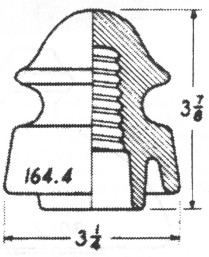
CD 164.4 is the signal style manufacture by Fry. It has been found in
blackglass and translucent Foval glass which is an opalescent color that takes
on different shades of colors in various lights. This is the most common style
of Fry glass insulators found to date. (Editor's Note: Your editor has also seen
this insulator in a translucent cobalt color. The piece was badly damaged, but
as one one looked up through the pinhole red rays came through the cobalt glass.
At this date and to my knowledge, this is the only Fry insulator that has been
located in cobalt.)
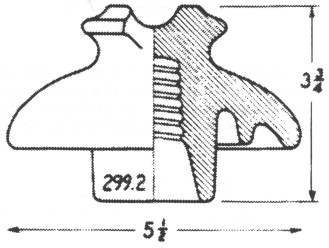
CD 299.2 is one of three cable style insulators made by Fry. All of the
cables are more uncommon. This style has been found in both pearl opalescent and
black glass. There are at least two opalescent and two blackglass insulators in
collections today.
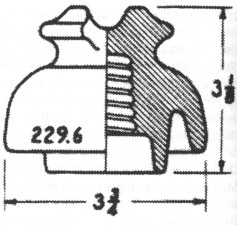
CD 229.6 is the smallest of the cable type Fry insulators and is only known to
exist in blackglass. There are at least two known to exist in collections.
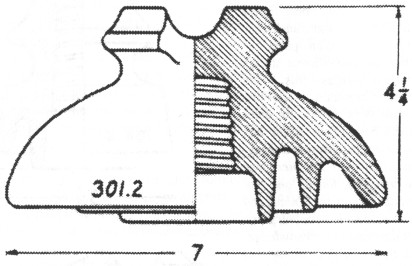
CD 301.2 is the largest cable style and has been found in an emerald green .
The glass is opaque and the emerald color shows only at the tip of the base
skirt when it is held up to bright sunlight.
The most interesting thing about the Fry glass insulators is that they are
distinctively different from any other manufactured insulator. Each of the
designs has only been manufactured by Fry and not by any other manufacturer of
insulators. If you have a representative the the four CD styles above, it has to
be FRY!
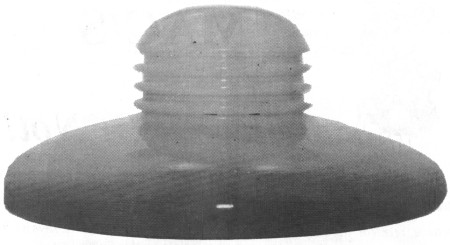
The only Fry Glass "sombrero" known to exist.
The most elusive of the Fry insulators manufactured is an insulator which
would have been used in a high tension string on power lines. It shape has been
nicknamed "sombrero" and it does not have a CD number. There is only
one known to exist (which is mint) and it is in the Foval Glass (opalescent)
color. You can only imagine what a complete string of these beauties would look
like hanging from a high tension tower! Appropriately, this one-of-a-kind Fry
resides in a Pennsylvania collection.
l am always in search of new information about FRY glass insulators. As I
often say to myself, "There is still something to be learned each
day!" Good collecting and May God Bless.
| 